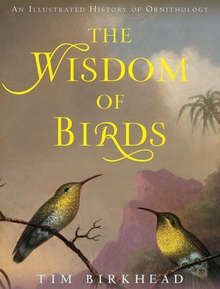Reviewed by Grant McCreary on March 2nd, 2009.
I really should know better than to judge a book by its cover. Yet that’s precisely what I did when I saw this book’s entry on an online retailer. The cover, and especially the title (more on that later), made me envision a small book, probably a miscellany of bird facts and quotes. Not the sort of thing that really interests me, so I didn’t look into it any further.
A few weeks later I encountered Wisdom again, but this time at a local bookstore. It was immediately obvious that my first preconception was wrong. The trim size was larger than anticipated, but the thickness was most surprising. This is one hefty book! So this time I looked at it in greater detail, leafing through the pages and reading the jacket. My initial judgment had been way off base. And I couldn’t have been more pleased.
We (the collective we) know a lot about birds, from identification to physiology to behavior. Take a large and complex topic like migration, for example. There is still plenty to learn, but for the most part, we know what species migrate, where they go, and how they get there. Moreover, the general mechanics of how and why they do so are also understood. But that wasn’t always the case. In fact, until relatively recently, the idea that birds migrated at all was controversial.
In this book, Birkhead explores this progression of knowledge and explains how we know the things that we do. He approaches this in a very interesting manner. This history is balanced around Birkhead’s pick for the most influential ornithologist of all time – John Ray. Don’t worry if you’ve never heard of him, you’re not the only one. He was a late 17th century English naturalist who wrote some very influential books. Birkhead believes that Ray “was the turning point”, and that his ideas “launched the study of modern ornithology”. Thus, Birkhead uses Ray as the fulcrum point in the history of ornithology:
This book is a journey during which we will assess Ray’s remarkable contribution to the study of birds, both by looking back at his predecessors and by looking forwards and exploring the range of topics that comprise modern ornithology.
These topics include:
- Development of chicks
- Instinct and intelligence
- Migration
- Breeding
- Territory
- Song
- Sex
- Infidelity
- Reproduction and longevity
For each of these, the author describes how our understanding of it has changed throughout time. This is important, because we tend to take these basic concepts for granted. Anyone interested in birds learns quickly that territory is very important. Indeed, it is one of the main reasons why birds sing. However, someone had to have that first spark of inspiration that this is so, and then carry out the necessary studies to prove it.
The choice to base a historical exploration around individual topics rather than chronology was a wise decision. A straight timeline of events, people, and theories from Aristotle to the present would have been impossible to keep straight. That approach may work in some cases, but not for this book’s purpose. I found this topic based approach very easy to read and understand.
On the other hand, it would seem like this organizational format would leave out a great deal. However, although this history is by no means comprehensive, Birkhead deftly uses these specific topics to illustrate general themes as well. For example, the discovery of the importance of territory is also used to show the shift in ornithology from a strictly museum based enterprise to one also conducted in the field.
In addition to learning about the study of birds, readers will also be presented with many interesting things about birds themselves. One of the things that I learned concerned the Ruff, a lekking European shorebird. The male’s breeding plumage includes a fantastic “ruff” of feathers on the neck. After breeding, however, the males molt into a female-like plumage. Thus, researchers studying these birds on their fall migration use size to determine the gender, since males are distinctly larger. But occasionally they encountered birds that were of intermediate size, so it was not obvious which sex they were. Eventually, it was determined that they were a previously unknown male morph that never develops the male’s normal breeding plumage. Why would some males not display their namesake feature, even though it is the primary characteristic females use to determine with whom they will mate? It turns out that these female look-alikes could safely remain on another male’s territory without incurring his wrath, and then attempted to sneak copulations with passing females!
This volume also includes a good number of high-quality reproductions of vintage paintings and diagrams. Ranging in origin from the medieval period through the early 20th century, they depict birds and activities mentioned in the text. I don’t know if they are sufficient to truly consider this an “illustrated history”, but they are definitely a welcome inclusion.
Recommendation
In The Wisdom of Birds, Birkhead takes a complicated and extensive subject and presents it in manner accessible to professionals and amateurs alike. Even more impressive is that it is fun to read! Don’t let the book’s size or subject put you off, as it would be unfortunate to let your preconceptions cause you to miss this wonderful book, as mine almost did.
Highly recommended to anyone interested in birds and their study.
Finally, a thought on this book’s seemingly awkward title. I believe it was meant as a homage to one of John Ray’s books – The Wisdom of God Manifested in the Works of the Creation.
Disclosure: I get a small commission for purchases made through links in this post.
Disclosure: The item reviewed here was a complementary review copy provided by the publisher. But the opinion expressed here is my own, it has not been influenced in any way.





Comment